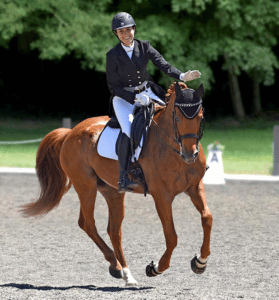Since the Olympic Gold medallist in Showjumping Peder Fredricson pulled the shoes of his horses and went barefoot, he has had far less issues with lameness, far fewer injuries to the hooves and lower limbs and not a single hoof abscess. And perhaps needless to say, his horses keep bringing home the gold like never before.
But why is that? For decades hoof rehabilitators and horse owners have experienced extraordinary results with taking previously shod horses barefoot, but there has been very little research done to support these results scientifically. Now, a new comprehensive research project by The Swedish Agricultural University (SLU) and Agria Animal Insurance is well on the way to scientifically determine the difference between a barefoot hoof and a shod horse hoof.
The research project is led by Professor Lars Roepstorff, who has been collecting data from riding tests and interviews throughout the past year and the study is expected to be finalized at the end of 2022. However, already the preliminary results from the first phase of the study shows that horseshoes do affect the function of the horse’s hooves.

Elite-level performance horses are being transitioned out of iron horseshoes like never before.
A Shod Hoof can’t Expand or Contract as much as a Barefoot Hoof
In this first stage of the study, the researchers have focussed on measuring how the hoof moves with and without horseshoes. It has previously been proven that horseshoes inhibit the hooves’ ability to expand when it lands on the ground, as it does naturally when the horse is barefoot. Although now Professor Lars Roepstorff has also been able to describe how the shod hooves’ ability to contract again afterwards, is also inhibited by the horseshoes.
“The iron shoe locks the so-called hoof mechanism especially when landing after obstacles. The shod hoof can’t expand or contract as much as the barefoot hoof because the shoe inhibits lateral movement. It could mean that the blood flow in the shod hooves is inhibited, and this blood flow is important for the hooves to be healthy,” Roepstorff explained to Agria Djurförsäkring.
The researchers still need to analyse further to determine what the actual consequences are of the hooves moving less with shoes – like how this affects blood circulation and the hooves’ ability to absorb shock. Next step in the study will be to analyse how the horses’ movements are affected more generally with and without shoes, for example in terms of stride length, stride height and angles.

It’s not only the rigid iron shoe itself that inhibits normal, healthy hoof function, but also the way the shoe is fixed onto the hoof with nails.
Protective Performance Hoof Boots can replace Iron Horseshoes
Traditionally, iron horseshoes have been used for protective purposes, but as the new barefoot study has shown, iron shoes also come with undesirable side effects. These findings have made Lars Roepstorff, the scientist in charge of the study, to call for alternative ways to protect horse hooves in the future:
“One would like to find alternatives to iron shoes that can handle the shoe’s most important functions; wear protection, anti-slip protection and protection against point loads, but at the same time allow a normal function of the hoof. I think that is the future,” Professor Lars Roepstorff said.
As opposed to iron horseshoes, which don’t cover the sensitive sole of the hoof, hoof boots cover and protect the entire surface under the hoof, which as a result provide superior point pressure protection. Hoof boots such as Scoot Boots, are lightweight, flexible, and super easy to slip on the horse when needed. Scoot Boots improve the barefoot horse’s shock absorbing properties and have been found to encourage the desired heel-first landings.
Hoof boots from Scoot Boots have been made for performance and the tread itself provides extraordinary grip on slippery surfaces. When extra grip is needed, such as in high-speed showjumping on wet, muddy grass, studs can be applied directly under the hoof boot providing the same, enhanced grip as studded horseshoes.

Get Barefoot Experts to Help Transition your Horse to Barefoot
The interest in taking previously shod horses barefoot is exploding worldwide both as an aid to rehab from various hoof issues and in order to improve the horses’ performance and soundness. However, Peder Fredricson and the two main figures behind the new Swedish barefoot study, veterinarian Staffan Lidbeck and Professor Lars Roepstorff, said that horse owners should seek competent assistance before pulling the shoes off their horses:
“It is important that anyone who wants their horse to walk without shoes gets competent help. In the beginning, the hooves may need to be trimmed every two weeks, and eventually the owner will find his routines so that the farrier can come less often,” Peder Fredricson said.
When a horse has barely ever touched the ground directly due to the application of horseshoes, you must expect some degree of foot soreness after removing the shoes. Sore feet could make your horse alter his gait and movements to avoid the pain, which could result in a whole other range of problems. As such, you want to ease the transition, and the best way of getting your horse used to touching the ground and rebuilding his hoof strength naturally, is by letting him wear some well-fitting, shock absorbing hoof boots.
In the blog How to Transition your Horse from Iron Shoes to Barefoot you’ll find a step-by-step guide on taking your horse barefoot and find out how to choose the best hoof care professional to assist you in making the transition from shod to barefoot a success for both you and your horse.

To Discover more head to Scoot Boots



